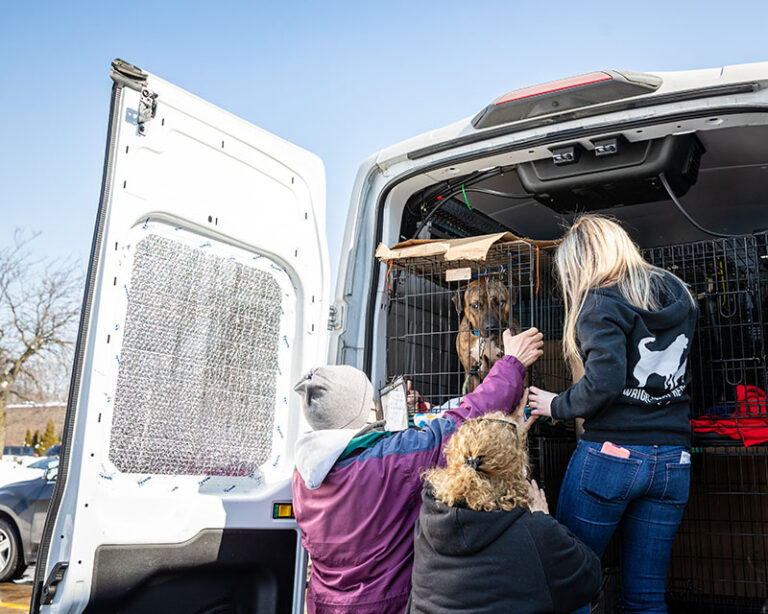When we heard about how Cincinnati Animal CARE Humane Society, in Cincinnati, Ohio, went from having zero fosters, to nearly 2,000 fosters, in just a year and a half—we obviously had to find out more!
We recently spoke with foster coordinator Amanda Graus about how in the world she did it, and lessons for other groups that want to build out their foster programs and become foster-centric organizations.
The following Q&A has been edited for length because honestly we could have talked to Amanda about fostering all day.
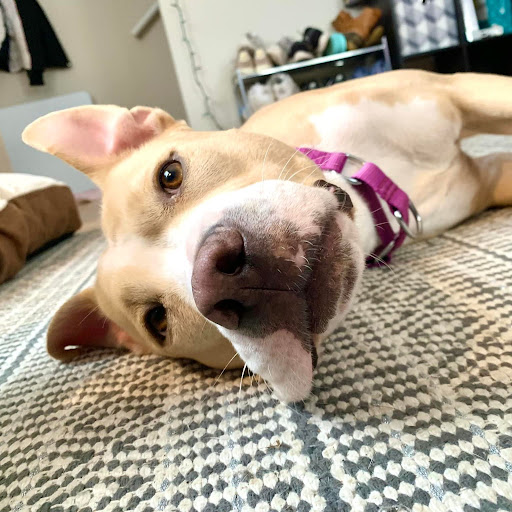
HASS: Do I have this right that you had zero foster program there at the shelter, and then in less than two years, you had a couple of thousand fosters?
Amanda Graus: Yes, we have about 1,928 fosters in our system currently!
We took over the Hamilton County Animal Shelter in Cincinnati, Ohio, in August of 2020. So we’ve been here about a year and a half now. We started from scratch.
When I came in, the main focus was recruitment. We were a full shelter, but the community was pretty behind us. They wanted to see change in their community.
We started doing email blasts, social media blasts on our main page. And then we built our base of fosters, probably just a couple hundred.
We started word of mouth, spreading the word, making flyers, putting our name out there anywhere we can.
HASS: So what did you say in your recruitment social media posts? How did you capture people’s attention there in the beginning?
Amanda Graus: A lot of people don’t know anything about fostering. You walk up to people on the street, a lot of people won’t know what you’re talking about.
They might act like they do, but a lot of people just don’t know the details that it’s literally providing a temporary home.
At least once a week make a basic post, and using emojis, bullet point everything, those basic posts of saying: “Hey, this is what fostering is. It is a temporary commitment.”
I think that was the biggest thing, is telling people what fostering is. A lot of people say, “We need fosters,” without describing what it is, what you need from them.
I think a call to action plea at the top is really important. If you need two-week fosters, if you’re overflowing right at that moment, say, “Hey, we need two-week fosters right now.”
And I think people seeing that call to action, seeing what fostering is, is what’s going to make them jump in. Not necessarily just saying, “Hey, come foster, come save a life.” Those are always good posts, but telling them what it is, why you need it, why you need fosters is really important.
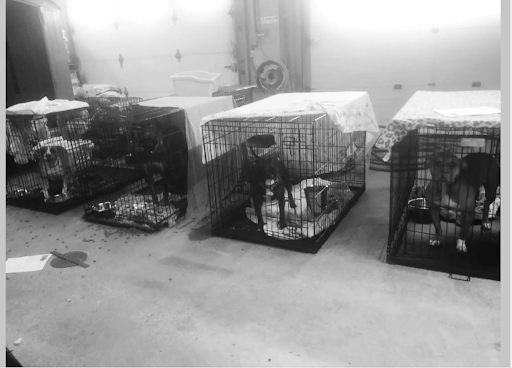
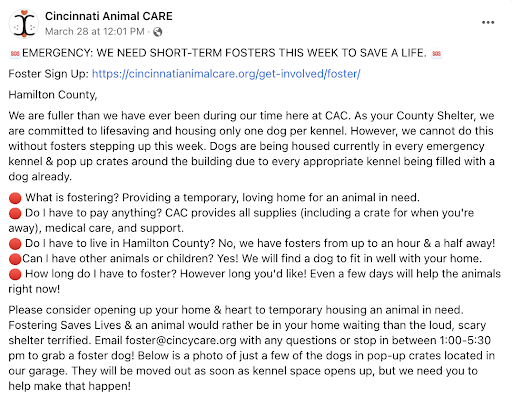
HASS: Do you feel like that builds transparency and trust, and also makes it seem manageable to people?
Amanda Graus: Definitely. I think it’s very important to be as transparent as you can possibly be. If you’re struggling, tell the community you are struggling to get these animals out, tell them that you are overflowing with animals.
They want to know why they need to help. So transparency is super important in that aspect of finding fosters and getting them here.
I know some organizations might get worried, “Oh, we can’t just ask for two-week fosters. They’re all going to return at the same time. They’re all going to do this, that.” I will say, when we ask for something like that, when I said that timeline in the post, most people will want to keep that animal longer.
A lot will adopt. Especially new fosters, a lot will adopt. It is a foster fail when they adopt, but it’s still a success. It’s still keeping that animal out the shelter. So that’s a win-win for us.
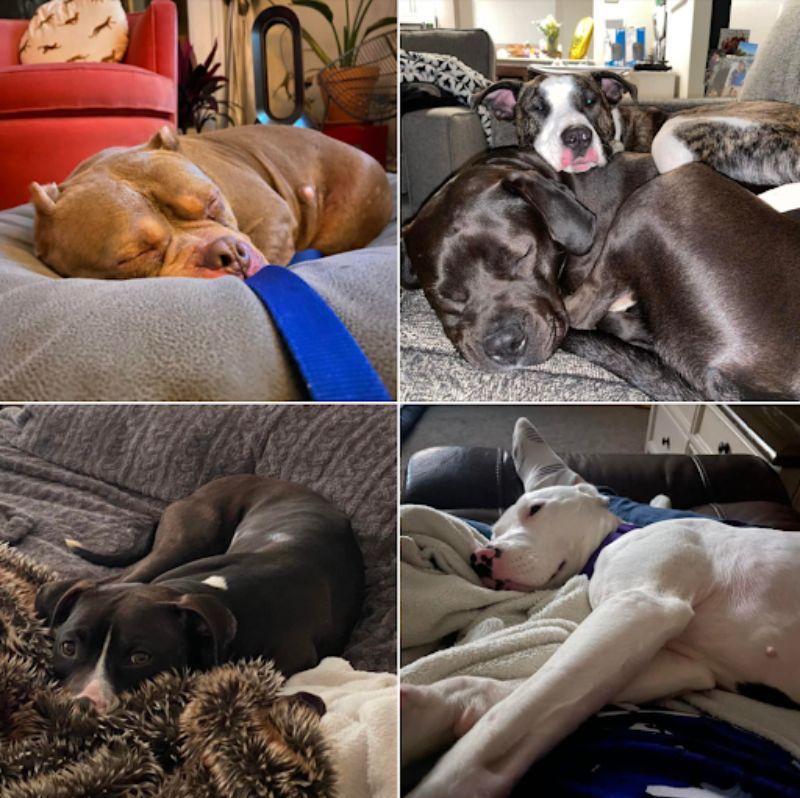
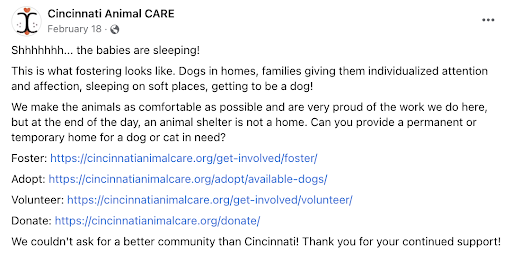
HASS: Are your fosters getting to know each other? Have they built a foster community? Do they have a Facebook page?
Amanda Graus: Yes. We have about almost 2,000 people in our foster Facebook group. Only approved fosters, employees, and board members can join it. That’s actually where we post a lot of our pleas.
Note: you can see some sample pleas in this document.
We use the term “foster family” with everyone, and we try to make it so everyone knows each other and is friends. A couple months ago we started holding something once a month, at a local brewery where everyone would meet up that wanted to come and be able to mingle with each other.
I think having that community and family feel when you become a foster is super, super important. There’s a lot that they can do to help you. In some of our pleas on the foster Facebook page, we put, “Can’t foster a dog right now, or already have a dog, but can’t grab another? Here’s what you can help with.” And we’ll put passing out flyers, word of mouth is the biggest thing.
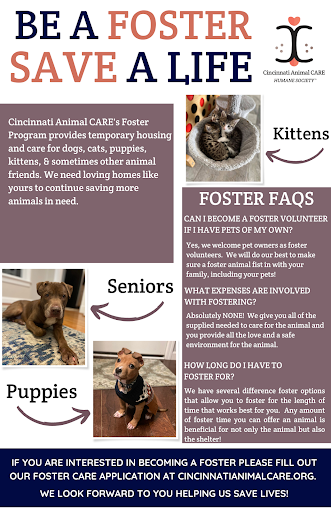
We’ve even had contests, who can recruit the most people in a week to foster with us, and done raffles for it.
Getting them engaged in your mission and allowing them to help you find fosters, asking them for what you need is really important.
Because they want to help. If they foster already, they want to help. They want to help in more ways than you could possibly know.
HASS: How many pets come through your shelter every year and how many pets are going into foster at this point?
Amanda Graus: I believe our intake last year, if I’m correct, is around 7,500. And then as far as what goes into foster, I think last year it was least 64%.
We’re trying to get to the 70% mark. We’ve gotten to it a few times with large dogs in foster.
Give yourself a goal and keep going up. You’re going to drop some months. You’re going to go up other months. Setting those goals as a program is super important because we have to know what our shelter needs.
We are in a very old shelter here. We only have 100 kennels, 100 usable kennels.
We are overflowing right now. We have about 140 dogs on site, with about 250 in foster right now.
So I think it’s just important to set your numbers, what you need at your shelter to keep it going, and try to reach that goal every time.
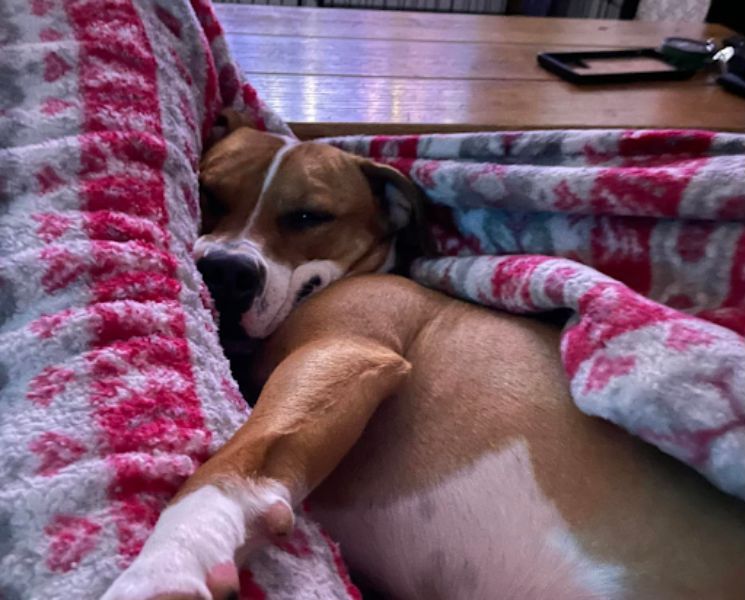

HASS: Can all pets go into foster? Is foster reserved for just some pets, or is it open to all the pets in the shelter?
Amanda Graus: We’ve learned that it’s very important to let any animal, as long as they’re safe, they’re healthy, to go into foster. There’s people who want specific animals. Why would I hold them here when we don’t have the capacity to hold them here, when they can get adopted and fostered just as easily?
We’re really big about allowing people to pick who they want to foster. Sometimes obviously like other shelters, there will be urgent needs to get animals out. And we do still do urgent posts and weekly emails with who really needs out.
But we never will not send an animal to foster that somebody wants to foster, because that’s helping an animal and that’s getting someone out and clearing a spot to help another animal.
HASS: How are your fosters involved with marketing the pets?
Amanda Graus: We have a basic marketing guide that we give them. We give them tons of different neighborhood groups to post in and everything like that. We have a few people in our foster Facebook group that are always posting ideas for fosters to go off of.
We started foster coaches, where if the foster doesn’t have time to market their animal, the coaches market the pet for them. They’re fosters who have been with us for a while, who have offered their services to volunteer and oversee newer fosters and other animals in foster. Because you obviously don’t want that animal to sit. An open foster home means they can help another animal.
The foster coaches are assigned fosters, and it’s their job to reach out to that foster, to ask them questions, to help them. We’ve realized that it really helps retain fosters. We’ve seen an increase in retainment of fosters, since they’re getting that support they need.
HASS: Do you have cats and dogs and other pets going into foster? Is it mostly dogs? What foster programs do you have?
Amanda Graus: Dogs is our big push because we don’t have a lot of cats and it’s not kitten season. Right now, we have almost every cat in foster. We might have five here right now actually available for adoption.
Kitten season is probably our biggest thing that we’re proud of. Every kitten who comes through our doors gets out the same day. We have a very robust kitten foster system thanks to our community stepping up.
Fosters sign up when they’re available to take kittens with the foster on deck form. Then it auto-populates into our spreadsheet. So it’s super easy when kittens come in, we just look at that spreadsheet, who’s available, who doesn’t have kittens, and give them a call.
That’s something that we’re proud of, that we’re hoping to have another good kitten season here and getting these little ones out into foster to help them thrive before adoption.
Amanda told us by email about these other foster programs as well:
- Day Trips: Take a dog out for the day to get a break from shelter life and help promote them to adopters!
- Short-Term Fosters: 3 days to 2 weeks.
- Long-Term Fosters: 2+ weeks—usually until adoption.
- Cruelty Case Fostering: Animals who are part of a pending case—typically long-term fosters until the case is over.
- Medical/Behavioral Fostering: Typically long-term fosters.
HASS: Does having so many pets in foster help the pets who are at the shelter?
Amanda Graus: We are finding that they get adopted a little quicker, most likely because we know more about them.
Before we took over, there were a lot of dogs per kennel here. So volunteers and staff just didn’t get to know the dogs as much, because there were so many here on site. Relying on that foster to get to know their dogs allows us to get to know dogs here who haven’t found that foster fit yet.
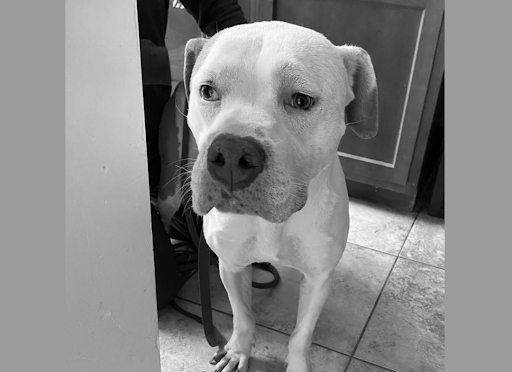
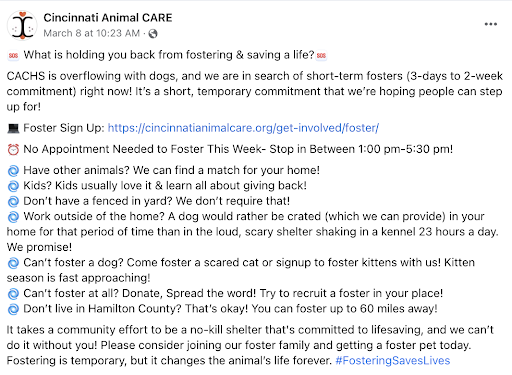
HASS: What would you recommend to other shelters? Let’s say there’s a shelter that wants to build out its foster program, they’re having a little trouble getting started or knowing how to do it. What would you tell them to start doing?
Amanda Graus: My first recommendation is definitely to get together as an organization. See what your goals are as an organization. Setting that goal for your organization, and what you think you can achieve. Then going out and seeing how you can achieve it.
I spoke to a rural shelter a couple days ago and I think what was important for them was growing their radius of who they allowed to foster. You might be in a small town, but there might be a big city an hour away. Believe it or not, those people want to foster for you. They do.
We have fosters up to an hour and a half away. As long as they can make it to our emergency clinics for emergencies, we will work around their schedule. Just broadening to a lot of fosters, putting down the barriers, including with location, allowing people to foster a little longer of a radius, as long as they’re willing to come to the shelter.
This might sound cliché, but I think it’s very important to join neighborhood groups. Get on Facebook, look at all your groups, look at even that group an hour away, join it, and just post that first plea. When people have never seen your name before, maybe not heard about you, it’s very important just to have them see something, anything.
HASS: I feel like this is so obvious and yet it feels so revelatory. You’re saying to look for communities where you don’t already have a lot of participation and just make efforts to reach out there, because all there is upside, right?
Amanda Graus: Yeah. Exactly. You should not be scared to reach out.
For example, there’s a city called Milford around us, and I didn’t realize I wasn’t in their neighborhood group. I joined it about three weeks ago. I just posted a simple thing where it said what fostering is, why your community needs you over in Cincinnati.
It might sound like a small number, but 15 new homes opened up. So that’s really what started it. So anything that you can do just to start that connection in a community is important, even if you think it’s small. I promise it will grow.
Learn more by checking out the HASS Foster-Centric Model toolkit.


